MAKE YOUR RIDE YOUR OWN WITH HARLEY-DAVIDSON CUSTOM PAINT
By Bandit | | General Posts


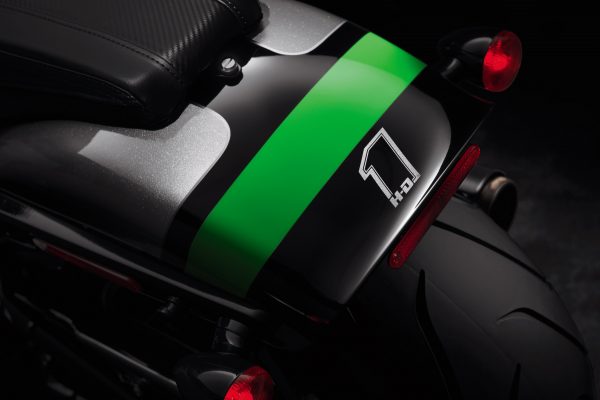

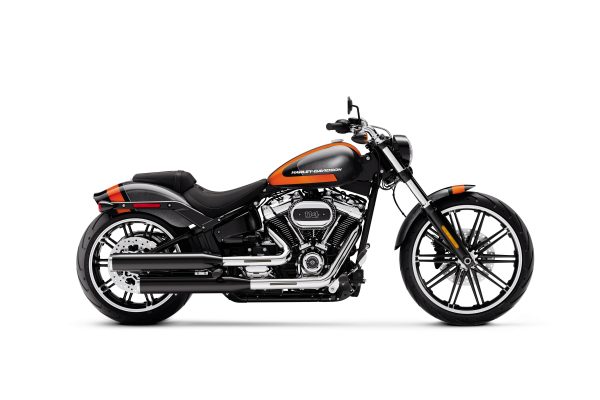
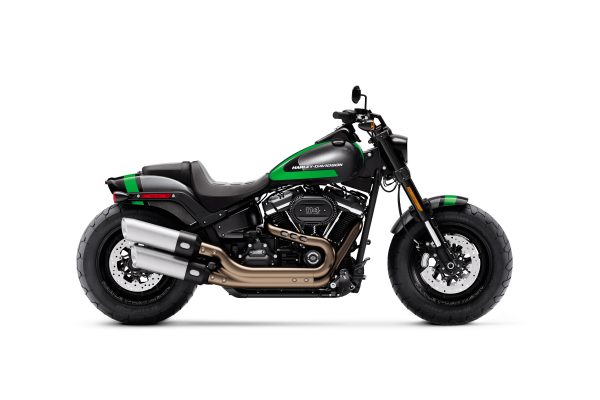
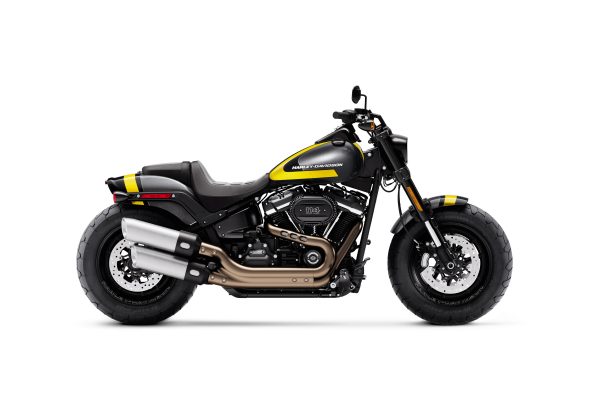
NEW MOTORCYCLE FILM: ELI COORY TRAVELS THE WORLD ON A MOTORCYCLE HELPING CHILDREN WITH CANCER
By Bandit | | General Posts
When Eli Coory contacted us and told us about Solo on Moto, the story behind it all, the noble cause he spent 5 years documenting for his film after meeting an 8-year old kid with cancer, we knew straightaway we had to share and show this film to worldwide audiences on Dream Racer TV.
What it is even more amazing, is that Eli Coory did Solo on Moto ‘himself’ — he shot every photo, every video, and editing his entire film himself, no sponsors, so support, simply  because he felt compelled to share his story and what he saw travelling the world. Needless to say that Solo on Moto film profit will head straight toward hospitals and charities supporting children with cancer. So don’t think twice about watching this movie online, you can rent it or even purchase Solo on Moto (better for the kids) — it is all toward supporting a good cause, and for something we all wish we never have to face ourselves.
because he felt compelled to share his story and what he saw travelling the world. Needless to say that Solo on Moto film profit will head straight toward hospitals and charities supporting children with cancer. So don’t think twice about watching this movie online, you can rent it or even purchase Solo on Moto (better for the kids) — it is all toward supporting a good cause, and for something we all wish we never have to face ourselves.
Now to the movie…
Solo on Moto is a 72-minute documentary film following Eli’s journey travelling the world for five years and more than 90,000 Facebook followers followed his journey.
From being stranded is war torn countries in the Middle East to making his way into Europe, then Africa and onto Brasil and its famous Rio de Janeiro Carnival, Solo on Moto is packed with images that will make you want to travel the world.
THIS MOVIE IS VERY INTERESTING, COLORFUL, INTENSE, MIX OF JOYFUL AND DRAMATIC EVENTS ACROSS THE WORLD. YOU MUST WATCH IT, YOU WILL NEVER BE THE SAME!
The ‘Solo on Moto’ documentary film even help us discover places that are several  thousands years old and offers viewers with a crash course in history. One of them touches on the history of Cappadocia which began in prehistoric times during the Bronze Age and in about the 2nd Millennium BC.
thousands years old and offers viewers with a crash course in history. One of them touches on the history of Cappadocia which began in prehistoric times during the Bronze Age and in about the 2nd Millennium BC.
Erosion shaped the incredible landscape of Turkey’s Göreme valley, but thousands of years ago humans took a cue from Mother Nature and began carving an incredible chamber and tunnel complex into the soft rock. Beginning in the fourth century A.D., an urbanized—but underground—cultural landscape was created here.
THIS IS UNDOUBTEDLY A MASTERPIECE. THANKS TO SUCH PEOPLE WHO ARE ABLE TO SACRIFICE THEMSELVES FOR THE LIVES OF OTHERS, AND ARE NOT AFRAID OF DANGER AND RISK.
 Ancient volcanic eruptions blanketed this region with thick ash, which solidified into a soft rock—called tuff—tens of meters thick. Wind and water went to work on this plateau, leaving only its harder elements behind to form a fairy tale landscape of cones, pillars, pinnacles, mushrooms, and chimneys, which stretch as far as 130 feet (40 meters) into the sky.
Ancient volcanic eruptions blanketed this region with thick ash, which solidified into a soft rock—called tuff—tens of meters thick. Wind and water went to work on this plateau, leaving only its harder elements behind to form a fairy tale landscape of cones, pillars, pinnacles, mushrooms, and chimneys, which stretch as far as 130 feet (40 meters) into the sky.
But human hands performed equally incredible works here. The rocky wonderland is honeycombed with a network of human-created caves; living quarters, places of worship, stables, and storehouses were all dug into the soft stone. In fact, tunnel complexes formed entire towns with as many as eight different stories hidden underground.
Ural x GPR 2-1 High Pipe
By Wayfarer | | General Posts

New highly anticipated 2-1 High Mount Exhaust System
Now available for purchase! Fits 2016 and up Gear Up, Patrol, cT
Designed specifically for off road use only
- Increased ground clearance
- Lightweight stainless steel (nearly 10lbs. lighter than stock Ural exhaust system)
- Internal mesh-type spark arrestor
- Serviceable GPR muffler designed exclusively for Ural Motorcycles
- Fits all 2016-2019 fuel injected models except Retro
- ….and of course, unmatched Italian design
Contact your local dealer, supply is limited.
MSRP* 1,399.00
*MSRP does not include shipping, installation, dealer prices may vary
Shared e-scooters aren’t as environmentally friendly as other transport options
By Wayfarer | | General Posts

A new study has found that e-scooters may be greener than most cars, but they can be less green than several other options.
Washington DC: People who think electric scooters or e-scooters are environmentally friendly, take note!
A new study has found that e-scooters may be greener than most cars, but they can be less green than several other options.
“E-scooter companies tout themselves as having little or no carbon footprint, which is a bold statement,” said Jeremiah Johnson, the corresponding author of the study
“We wanted to look broadly at the environmental impacts of shared e-scooters – and how that compares to other local transportation options.”
To capture the impact of e-scooters, researchers looked at emissions associated with four aspects of each scooter’s life cycle: the production of the materials and components that go into each scooter; the manufacturing process; shipping the scooter from the manufacturer to its city of use; and collecting, charging and redistributing the scooters.
The researchers also conducted a small-scale survey of e-scooter riders to see what modes of transportation they would have used if they hadn’t used an e-scooter.
The researchers found that 49 per cent of riders would have biked or walked; 34 per cent would have used a car; 11 per cent would have taken a bus; and 7 per cent wouldn’t have taken the trip at all.
In order to compare the impact of e-scooters to that of other transport options, the researchers looked at previously published life cycle analyses of cars, buses, electric mopeds, and bicycles.
Researchers looked at four types of pollution and environmental impact: climate change impact; nutrient loading in water; respiratory health impacts related to air pollution; and acidification.
The performance results were similar for all four types of pollution.
“A lot of what we found is pretty complicated, but a few things were clear,” said Johnson.
“Biking – even with an electric bike – is almost always more environmentally friendly than using a shared e-scooter. The sole possible exception is for people who use pay-to-ride bike-share programs. Those companies use cars and trucks to redistribute the bicycles in their service area, which can sometimes make them less environmentally friendly than using an e-scooter.”
By the same token, the study found that driving a car is almost always less environmentally friendly than using an e-scooter.
But some results may surprise you. For example, taking the bus on a route with high ridership is usually more environmentally friendly than an e-scooter.
“We found that the environmental impact from the electricity used to charge the e-scooters is fairly small – about 5 per cent of its overall impact,” said Johnson. “The real impact comes largely from two areas: using other vehicles to collect and redistribute the scooters; and emissions related to producing the materials and components that go into each scooter.”
That means that there are two major factors that contribute to each scooter’s environmental footprint. First is that the less driving that is done to collect and redistribute the scooters, the smaller the impact. The second factor is the scooters’ lifetime: the longer the scooter is in service, the more time it has to offset the impact caused by making all of its constituent parts.
Triumph Resurrects Its Torque Monster, The Rocket III
By J&P Cycles | | General Posts

– Triumph has kitted it with Showa adjustable suspension components and Brembo Stylema brakes.
– India debut expected by early 2020.





July 2019 Was Not the Warmest on Record
By Bandit | | General Posts
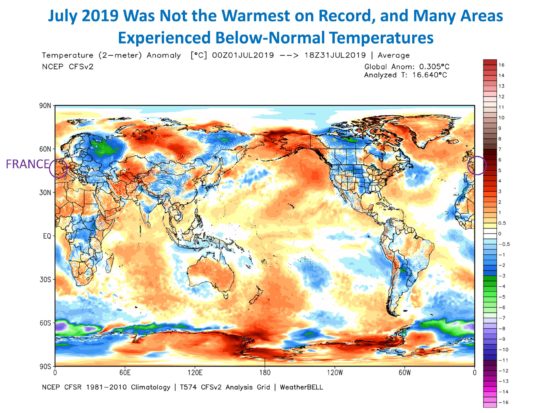 August 2nd, 2019 by Roy W. Spencer, Ph. D.
August 2nd, 2019 by Roy W. Spencer, Ph. D.
July 2019 was probably the 4th warmest of the last 41 years. Global “reanalysis” datasets need to start being used for monitoring of global surface temperatures. [NOTE: It turns out that the WMO, which announced July 2019 as a near-record, relies upon the ERA5 reanalysis which apparently departs substantially from the CFSv2 reanalysis, making my proposed reliance on only reanalysis data for surface temperature monitoring also subject to considerable uncertainty].
We are now seeing news reports (e.g. CNN, BBC, Reuters) that July 2019 was the hottest month on record for global average surface air temperatures.
One would think that the very best data would be used to make this assessment. After all, it comes from official government sources (such as NOAA, and the World Meteorological Organization [WMO]).
But current official pronouncements of global temperature records come from a fairly limited and error-prone array of thermometers which were never intended to measure global temperature trends. The global surface thermometer network has three major problems when it comes to getting global-average temperatures:
(1) The urban heat island (UHI) effect has caused a gradual warming of most land thermometer sites due to encroachment of buildings, parking lots, air conditioning units, vehicles, etc. These effects are localized, not indicative of most of the global land surface (which remains most rural), and not caused by increasing carbon dioxide in the atmosphere. Because UHI warming “looks like” global warming, it is difficult to remove from the data. In fact, NOAA’s efforts to make UHI-contaminated data look like rural data seems to have had the opposite effect. The best strategy would be to simply use only the best (most rural) sited thermometers. This is currently not done.
(2) Ocean temperatures are notoriously uncertain due to changing temperature measurement technologies (canvas buckets thrown overboard to get a sea surface temperature sample long ago, ship engine water intake temperatures more recently, buoys, satellite measurements only since about 1983, etc.)
(3) Both land and ocean temperatures are notoriously incomplete geographically. How does one estimate temperatures in a 1 million square mile area where no measurements exist?
There’s a better way.
A more complete picture: Global Reanalysis datasets
(If you want to ignore my explanation of why reanalysis estimates of monthly global temperatures should be trusted over official government pronouncements, skip to the next section.)
Various weather forecast centers around the world have experts who take a wide variety of data from many sources and figure out which ones have information about the weather and which ones don’t.
But, how can they know the difference? Because good data produce good weather forecasts; bad data don’t.
The data sources include surface thermometers, buoys, and ships (as do the “official” global temperature calculations), but they also add in weather balloons, commercial aircraft data, and a wide variety of satellite data sources.
Why would one use non-surface data to get better surface temperature measurements? Since surface weather affects weather conditions higher in the atmosphere (and vice versa), one can get a better estimate of global average surface temperature if you have satellite measurements of upper air temperatures on a global basis and in regions where no surface data exist. Knowing whether there is a warm or cold airmass there from satellite data is better than knowing nothing at all.
Furthermore, weather systems move. And this is the beauty of reanalysis datasets: Because all of the various data sources have been thoroughly researched to see what mixture of them provide the best weather forecasts
(including adjustments for possible instrumental biases and drifts over time), we know that the physical consistency of the various data inputs was also optimized.
Part of this process is making forecasts to get “data” where no data exists. Because weather systems continuously move around the world, the equations of motion, thermodynamics, and moisture can be used to estimate temperatures where no data exists by doing a “physics extrapolation” using data observed on one day in one area, then watching how those atmospheric characteristics are carried into an area with no data on the next day. This is how we knew there were going to be some exceeding hot days in France recently: a hot Saharan air layer was forecast to move from the Sahara desert into western Europe.
This kind of physics-based extrapolation (which is what weather forecasting is) is much more realistic than (for example) using land surface temperatures in July around the Arctic Ocean to simply guess temperatures out over the cold ocean water and ice where summer temperatures seldom rise much above freezing. This is actually one of the questionable techniques used (by NASA GISS) to get temperature estimates where no data exists.
If you think the reanalysis technique sounds suspect, once again I point out it is used for your daily weather forecast. We like to make fun of how poor some weather forecasts can be, but the objective evidence is that forecasts out 2-3 days are pretty accurate, and continue to improve over time.
The Reanalysis picture for July 2019
The only reanalysis data I am aware of that is available in near real time to the public is from WeatherBell.com, and comes from NOAA’s Climate Forecast System Version 2 (CFSv2).
The plot of surface temperature departures from the 1981-2010 mean for July 2019 shows a global average warmth of just over 0.3 C (0.5 deg. F) above normal:
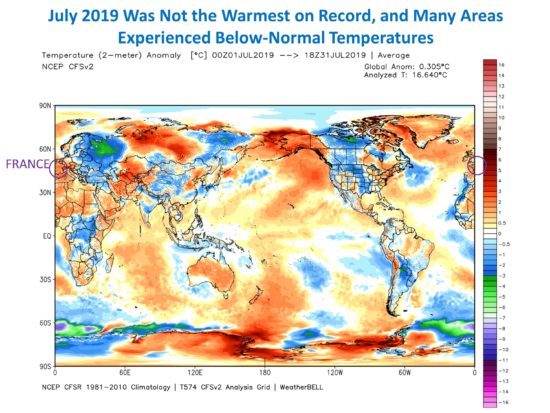
Note from that figure how distorted the news reporting was concerning the temporary hot spells in France, which the media reports said contributed to global-average warmth. Yes, it was unusually warm in France in July. But look at the cold in Eastern Europe and western Russia. Where was the reporting on that? How about the fact that the U.S. was, on average, below normal?
The CFSv2 reanalysis dataset goes back to only 1979, and from it we find that July 2019 was actually cooler than three other Julys: 2016, 2002, and 2017, and so was 4th warmest in 41 years. And being only 0.5 deg. F above average is not terribly alarming.
Our UAH lower tropospheric temperature measurements had July 2019 as the third warmest, behind 1998 and 2016, at +0.38 C above normal.
Why don’t the people who track global temperatures use the reanalysis datasets?
The main limitation with the reanalysis datasets is that most only go back to 1979, and I believe at least one goes back to the 1950s. Since people who monitor global temperature trends want data as far back as possible (at least 1900 or before) they can legitimately say they want to construct their own datasets from the longest record of data: from surface thermometers.
But most warming has (arguably) occurred in the last 50 years, and if one is trying to tie global temperature to greenhouse gas emissions, the period since 1979 (the last 40+ years) seems sufficient since that is the period with the greatest greenhouse gas emissions and so when the most warming should be observed.
So, I suggest that the global reanalysis datasets be used to give a more accurate estimate of changes in global temperature for the purposes of monitoring warming trends over the last 40 years, and going forward in time. They are clearly the most physically-based datasets, having been optimized to produce the best weather forecasts, and are less prone to ad hoc fiddling with adjustments to get what the dataset provider thinks should be the answer, rather than letting the physics of the atmosphere decide.
Are We Slinking Ever Closer to a Universal Road User Charge? Part 3
By Bandit | | General Posts
 In Parts One and Two of this series, Are We Slinking Ever Closer to a Universal Road User Charge?, we explored what is happening on the national level and in Congress respectively. Road User Charges (RUC) are also called Vehicle Miles Traveled Tax (VMT) or Mileage-Based User Fees (MBUF). A number of states are experimenting with RUCs on a limited number of motorists. Other states are thinking about doing the same since lawmakers don’t seem to have the stomach to raise fuel taxes or keep their hands off of fuel tax money for pet, non-highway projects rather than to help maintain road infrastructure.
In Parts One and Two of this series, Are We Slinking Ever Closer to a Universal Road User Charge?, we explored what is happening on the national level and in Congress respectively. Road User Charges (RUC) are also called Vehicle Miles Traveled Tax (VMT) or Mileage-Based User Fees (MBUF). A number of states are experimenting with RUCs on a limited number of motorists. Other states are thinking about doing the same since lawmakers don’t seem to have the stomach to raise fuel taxes or keep their hands off of fuel tax money for pet, non-highway projects rather than to help maintain road infrastructure.
In February, the Federal Highway Administration (FHWA) awarded over $10 million to seven states to test fees assessed to motorists based on how many miles they traveled. Those seven states are California, Delaware, Minnesota, Missouri, New Hampshire, Oregon, and Utah.
Receiving the most extensive grant of $3 million, the state of Delaware currently spearheads the I-95 Corridor Coalition which includes Pennsylvania. The new funding will expand the test program to include partnerships with New Jersey, North Carolina, and Virginia. In 2018, the first phase included a test pilot of 155 motorists. Beginning in October 2019, the second phase involves a multistate pilot of 59 trucks from four motor carriers.
Utah will use its one million dollars of federal grant money to launch an RUC program for electric and hybrid vehicles. Vehicle owners can decide on two options of how to pay: either a flat yearly fee or an RUC fee that will not exceed the amount of the annual charge. Utah’s DOT wants to test how participants will react to privacy and security concerns.
No state though, has done more testing than Oregon. In 2007, Oregon’s Road User Fee Task Force began conducting its first vehicle-miles-traveled tax experiment. In June, Governor Kate Brown announced that the state would expand its voluntary RUC program called OReGo. Motorists in the program plug in a small dongle into their car’s on-board diagnostic port that keeps track of miles driven and fuel consumption. The current charge is set at 1.7 cents per mile but starting January 1, 2020, that charge will keep pace with increases in fuel tax rates. Instead of capping the number of participants, OReGo will now allow anyone who can prove their vehicle receives 20 miles or more to the gallon to utilize a road user fee instead of a gas tax. Also, participants who operate electric vehicles that get 40+ miles per gallon would be exempt from mpg-based registration fee increases.
Even though Hawaii was not one of the states receiving the FHWA funds, it’s DOT earlier this year conducted a listening tour to discuss with citizens a proposed RUC test that will begin this fall. A decade ago, Hawaii set an ambitious goal to reduce its dependence on oil and create a green energy future by the year 2045. Currently, the state fuel tax is 0.16 cents per gallon, which has not changed since 1992. Fuel taxes provide about $83 million or 30 percent of the total $275 million revenue for the state’s highway fund each year. The Hawaii DOT says this share of funding started to decline in 2017. Currently, there are around 8,000 electric vehicles on the road in Hawaii, which makes up about one percent of all vehicles.
During the listening sessions, many motorists were upset to learn more about the new tax. At Kapolei High School, the police had to be called to calm down angry drivers who challenged state officials on the tax proposal. In another session, a resident pointed out that those living in Hawaii have no other reliable transportation except for driving their own car. Many residents stated in the meetings between yearly registration fees, safety inspections, and the cost of living, they could not afford any additional transportation costs.
State Representative Sharon Har said in an interview that drivers in her district felt that charging by the mile would be less fair since the more “affluent” residents live in urban Honolulu whereas the less wealthy live in the rural areas and must commute longer distances.
During the three-year pilot program, participants will receive an annual report of how much they drove (and how much they would have had to pay based on miles traveled) between safety inspections and how much they paid in fuel tax. Following the initial phase, 2000 volunteers would then either be tracked with similar tech as the Oregon pilot or through annual safety checks. The study will not include trucks or other commercial vehicles since the DOT claims there has not yet been a decrease in diesel tax revenue.
The State Smart Transportation Initiative and Smart Growth America stated in a recent study that the state of Hawaii still needs to curb how much Hawaiians drive to make their 2045 emissions goal. The study also found that if the state does not cut vehicle miles traveled, then the energy grid would need to produce one-third more energy than presently. Both groups suggested in the study that the state should pair electric vehicles with mixed-use land development, and better mobility choices to reduce the vehicle miles traveled by 20 percent to reach the emissions target within the next two to three decades.
Nearly every state in the country has road infrastructure funding issues and a myriad of political issues. Fabricating a way to charge motorists by the mile is ripe for abuse both in how the program is carried out and by utilizing yet another way to charge drivers when many have no other choice but to drive for work and family commitments.
–from the NMA
Flying motorcycle available for preorder in Japan from October
By Bandit | | General Posts
Baku, August 3, AZERTAC
Tokyo-based start-up A.L.I. Technologies Inc. plans to start accepting reservations for its hover bike flying motorcycle from October, company officials said Thursday, according to Japanese Jiji Press news agency.
The startup company, which mainly develops small unmanned aerial vehicles, will unveil the product at the Tokyo Motor Show in autumn.
It aims to sell the product mainly to wealthy foreigners, by touting its cutting-edge technologies. Preordering will start for about 100 special limited-edition units of the vehicle.
Using propeller power, the product is said to be able to hover up to around 10 meters above the ground, with its top speed at around 200 kph.
The hover bike is mainly intended for leisure. Use on public roads has not been permitted in Japan. Its price is expected to be roughly the same as that of a luxury sports car.
The company will deliver the hover bike from around the second half of 2020. A test drive event will be held in Dubai early next year.
“I hope the exhibition of the new product at the Tokyo Motor Show will motivate the young generation to create such products with advanced technologies,” A.L.I. Technologies Chairman Shuhei Komatsu said.
The upcoming bagger from the American manufacturer will house an all-new powerplant
By Bandit | | General Posts
- It is powered by an all-new liquid-cooled motor called ‘Powerplus 108.’
- A near-production version of the bike was spotted a few months back.
American bike maker Indian Motorcycle is planning to launch a brand new motorcycle, of which the images have already leaked online. This time though, instead of some grainy images, a video has been leaked, which confirms the name of the upcoming bike. Meet the Indian Challenger. And this shouldn’t come as a surprise as the bike maker had trademarked this name back in April.
Apart from the imposing name, the leaked video reveals other interesting bits as well. The test mule which was spotted was seen with a liquid-cooled motor, but details about the engine were limited back then. What we do know for sure that the engine will be called ‘Powerplus 108’ and will displace 1770cc and produce 120PS.
The cycle parts seem to be similar to the ones which were seen in the spy shots. Now, we have done a detailed story on the Challenger and two other upcoming Indian motorcycles, which you can read here.
As of now, there’s no word about its official launch, but we expect Indian Motorcycle to unveil the Challenger by the end of this month.
Source: zigwheels.com
Extra staff hired, jail space prepared for Sturgis motorcycle rally
By Bandit | | General Posts

STURGIS, S.D. — Law enforcement agencies in Meade and Pennington counties are hiring more officers, temporarily opening a second jail and keeping a courthouse open seven days a week for the Sturgis motorcycle rally and the hundreds of thousands of free-wheeling visitors it will attract over the next several days.
“We’re already busy,” Sturgis Police Chief Geody VanDewater said before the rally officially began Friday, Aug. 2.
VanDewater wouldn’t say how many temporary officers he hires but said they come from South Dakota, North Dakota, Colorado, Minnesota and other neighboring states. Some are working the rally for the first time while others, like one officer who is returning for his 41st rally, are repeat visitors.
Permanent officers will continue to work 12-hour shifts with no days off during the 10-day event, VanDewater said.
Meade County Sheriff Ron Merwin also hires temporary deputies, mostly relying on the office’s own reserve deputies and officers with Game, Fish & Parks. The Pennington County Sheriff’s Office hired eight deputies from South Dakota and neighboring states and will also have about 10 of its reserve deputies working full-time, said Chief Deputy Willie Whelchel.
The eight temporary deputies are assigned to two-person foot patrols in the office’s contract communities of Wall, New Underwood, Keystone and Hill City, Whelchel said.
The Rapid City Police Department didn’t hire extra staff and isn’t requiring its officers to work overtime as they have in past years, said Captain James Johns.
During the rally, the Meade County court remains open during the weekends and the old jail — located in the basement of the courthouse across the parking lot from the new jail — is reopened, Merwin said. Extra staff from the area is hired to help the corrections officers, but they don’t carry handcuffs or weapons.
The old jail has large group cells made of “old iron bars” and “doors that clang and bang” that hold about 25 people, Merwin said. When people are arrested, they’re first brought to the old jail to be booked and detained until their court date the next morning. Guards take away their belts and shoes for safety reasons, but let them wear their street clothes. If defendants can’t make bond, they’re moved to the new jail.
“Every day, we clean out the old jail and get ready for a new batch,” Merwin said. “It is quite a procedure. It’s been working for years and everybody is pretty conscientious about everybody’s rights, and we try not to do anything different than we do any other time of the year.”
The Pennington County court functions as normal during the rally and while no extra jail staff is hired, workers aren’t allowed to take vacation or do any special training, Whelchel said.
Enforcement priorities
“You name it, we have it here,” VanDewater said about the crimes he sees during the rally.
But he said the most common issues Sturgis police officers deal with are people parking where they’re not allowed to, followed by drunken driving and drug use.
Cars and motorcycles illegally parked in alleys, handicap spots and other off-limits areas are ticketed and towed to impound lots, the police chief said. “If we just leave them there, we’re not fixing the problem.”
“We allow officer discretion. We just ask that the issue is addressed,” VanDewater said when asked if his officers have to let some violations slide since they’re so busy. “We give more verbal warnings than we do citations.”
VanDewater said officers may give warnings to people urinating in public, carrying open alcohol containers and breaking traffic rules by speeding or not wearing a seat belt. But anyone charged with violent crimes or DUIs will be arrested.
“They will go to jail, and we don’t need them hurting themselves or especially someone else,” he said of drunken drivers.
James said most of the Sturgis activity in Pennington County takes place outside city limits, on the highways, and in Wall and the Mount Rushmore areas. Rapid City officers are mostly focused on road safety and noted some popular stores and venues, such as the Harley-Davidson dealership in Rapid City, provide their own security. He said the department’s goal is to make sure things go smoothly and seem normal for those who work and live in Rapid City.
Pennington County deputies focus on traffic safety and stopping drunken drivers as they prepare for six or seven major motorcycle rides that cross through the county, Whelchel said. Deputies make sure they’re visible and stationed around the county so they can quickly respond to emergencies.
“We want to be able to save lives. That’s our goal every day we come to work,” he said.
Whelchel and James agreed that it’s important to distinguish between those who are recklessly breaking traffic laws and those who may make a mistake because they’re tourists who aren’t familiar with the area.
“We got to help educate folks and guide them,” Whelchel said.
James and VanDewater said they’re not worried about how the rally will be impacted by South Dakota’s new law that says permits aren’t needed to carry a concealed weapon. They said officers are already trained to act as if anyone could be armed.





